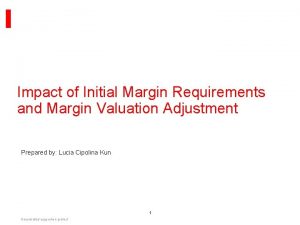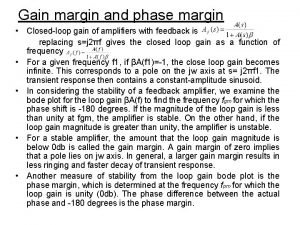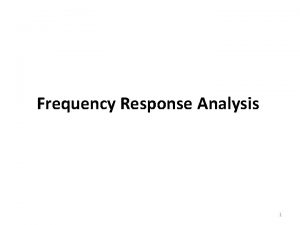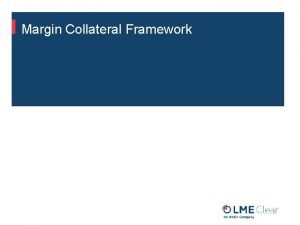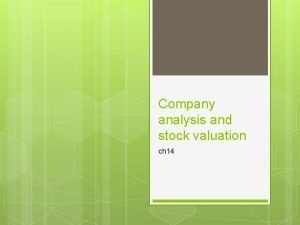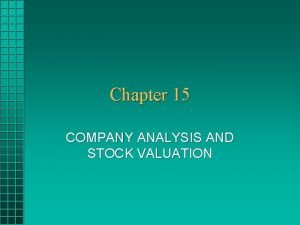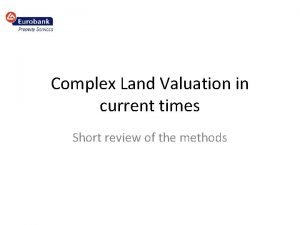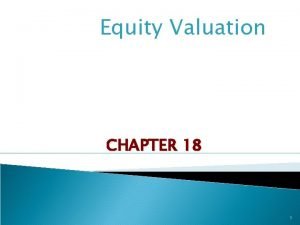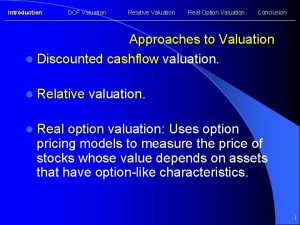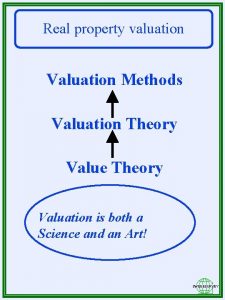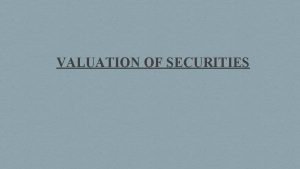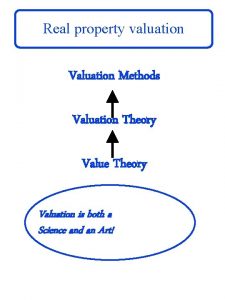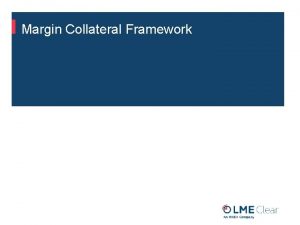Impact of Initial Margin Requirements and Margin Valuation

















- Slides: 17

Impact of Initial Margin Requirements and Margin Valuation Adjustment Prepared by: Lucia Cipolina Kun 1 Uncontrolled copy when printed

Agenda · Why the focus on Initial Margin? New Margin Requirements · How is Initial Margin Calculated? Differences between Bilateral and CCP Margining · Impacts of Initial Margin on XVA and Trade profitability · Impacts of Initial Margin on Funding Costs: How MVA arises from Initial Margin. · Other impacts of Initial Margin: Impact on Liquidity and availability of Collateral 2

Initial Margin - Why the fuzz ? Risk Magazine November 2015: The non-cleared margin rules will result in trillions of dollars of additional initial margin being posted, according to predictions from industry groups. “Adjustments to derivatives pricing to take into account the cost of funding initial margin for un-cleared trades will be a "game changer" that will overshadow existing adjustments for counterparty credit risk, according to valuation experts. ” the calculation of MVA will become more of a focus for banks as the rules come into force, particularly as the regime will reduce the significance of other valuation adjustments. Study by the FED: In total, regulators have estimated the amount of margin required of US entities at $315 billion, once the rules have been fully phased in to cover smaller banks, buy-side firms and other larger derivatives users. The annual funding bill has been roughly estimated at $2. 5 billion, using borrowing rates derived from banks' five-year credit default swap spreads 3

The New Basel Framework for Counterparty risk Mitigation through Collateral • Promoting Central Clearing: • All standardized OTC derivatives contracts should be traded on exchanges (CCPs) or electronic trading platforms by the end of 2012 at the latest, and cleared through CCPs • Non-centrally cleared contracts should be subject to higher capital requirements. · Counterparties trading OTC derivatives need to exchange both Variation Margin to cover current exposure and Initial Margin to cover potential future exposure. We will expand on this. · There is a suggested list of permitted collateral, which includes cash and highly liquid risky collateral such as bonds, equity and gold. In the latter cases, it must suffer a haircut to account for its riskiness. · Variation Margin can be re-hypothecated, but Initial Margin cannot. This is going to have very important risk management and cost implications for the banking industry. · These margining requirements will be introduced during a phase-in period. Originally it was intended to start in December 2015, but this has now been pushed back to September 2016. Any Covered entity with a notional amount of non-cleared OTC derivative above € 3. 0 trillion must start exchanging margin from this date. This threshold level becomes gradually lower over a four year period, down to a level of € 8 billion in 2020. 4

The Role of Variation and Initial Margin • Variation Margin – Covers the potential losses due to the fluctuation in Mt. M of a position. If a default were to occur, the current exposure of the surviving firm would then be limited and would more likely be covered by the initial margin. • Initial Margin – In the event of a default, the surviving firm could face losses resulting from an increase in replacement costs from the time of default to the time when the positions are unwound or replaced (i. e. the “MPo. R”). Portfolio Value Potential Exposure collateralized by IM Current Exposure collateralized by VM T Default Dispute 5 Fail Grace Period Margin Period of Risk Close Out T +10 d Time

How IM Funding Works – MVA as a Funding Adjustment CASE 1: Trade with a CCP · The IM is calculated by the CCP using a proprietary model. Only one party (the Bank) posts IM. · The figure below shows the exchange of cash flows on a given day. – – – Consider the case where the Bank trades with a Corporate under a CSA and hedges the deal through a CCP. The Bank will exchange Collateral with the Counterparty due to the Variation Margin (d. NPV). The Bank can rehypotheticate the Variation Margin to the CCP but not the IM. Giving that there is no IM received, the Bank must borrow unsecured to fund the IM raising the MVA. The Bank will also receive remuneration from the CCP only on cash posted. Client Bank Bilateral exchange of Collateral under the CSA Variation Margin (d. NPV) CCP Treasury 6

How IM Funding Works – MVA as a Funding Adjustment CASE 2: Uncleared Trade (Bilateral Margin) · Both parties exchange collateral but this cannot be rehypothecated. · The figure below shows the exchange of cash flows on a given day. – – – Consider the case where the Bank trades with a client under a CSA. The Bank will exchange Variation and Initial Margin with the Counterparty. The Bank can rehypotheticate the Variation Margin but not the IM, which will be posted in a Segregated Account. The Bank must borrow unsecured to fund the IM giving raise to the MVA. The Bank will not receive nor pay remuneration on the IM exchanged. Initial Margin Post IM into a Segregated Account (Custodian) Bank Client Bilateral exchange of Variation Margin (d. NPV) Initial Margin Post IM into a Segregated Account (Custodian) 7 Treasury

Expected Impact of the New Regulation on the Cost of Trading Regulatory Changes Impacts • Two Way IM Posting • New margin Agreements (Reg IM and Reg VM) • Increased Collateral Segregation • New Margin Call Calculations for all counterparties • Multiple CSAs under a single ISDA master agreement • Increased margin calls • Increased collateral movements and substitutions • Increased margin call disputes • Standard thresholds, collateral eligibility and haircuts 8

Margin Valuation Adjustment - Why a new XVA? · MVA is the result of recent regulations issued for margin rules. It is the negative adjustment to Pn. L to account for the funding costs of bilaterally or centrally cleared Initial Margin over the lifetime of the transaction. In the CCP case, the IM may also include the Default Funds and other Add-Ons needed to post to the CCP · By analogy with all of the other valuation adjustments, if there is a computation of margin, the effect of that computation should be included into the price. We can think of MVA as an “FVA of the IM” · Intuitively initial margin must be funded as in most cases rehypothecation of the initial margin is not allowed (and it’s usually segregated). · MVA is not Coll. VA as the first one accounts for the funding costs of the Initial Margin and the second one for Collateral–specific items such as: embedded optionalities on the collateral posted vs the one received, or different collateral qualities etc. 9

How MVA is calculated (1/2) Theoretical Setting · Intuition: The MVA is the expected discounted costs of funding initial margins including the joint survival probability (bank and ctpty) · One can also include the Variation Margin as it’s a cost to the Bank, in particular, it can create liquidity problems. · For a single trade, the MVA for its entire life can be approximated on continuous time as: 10

How MVA is calculated (2/2) Interaction between MVA and Dynamic Initial Margin 11

Impact of Initial Margin on XVAs Study by Gregory Reducing Counterparty risk comes at the cost of increasing funding risk Initial Margin transforms the XVA components: CVA/DVA (decrease), FVA (decrease) , KVA (expected to decrease with lower CVA) while MVA increases for both the uncleared and cleared deals. 12

What are the impacts of MVA to the cost of trading? · Study by Green Table of MVA costs for three separate portfolios. For the two off market portfolios the MVA is around 40% of the unsecured FVA, making it a significant contributor to overall Pn. L. Even with the well matched portfolio MVA adds two basis points to costs in a market that pre-crisis quoted bid-offer spreads around 0. 25 basis point. 13

How is the Industry reacting to MVA? Study by Gregory 14

Appendix: P VS Q Traditionally, simulations for Risk are done on the “Real” world measure P (i. e. historical scenarios), while for pricing this are done under the Risk-adjusted (risk-neutral) measure Q. This poses a challenge for the MVA as we need to merge Risk Neutral with Real world valuations (the SIMM is calibrated under P but used to adjust prices under the Q measure). The measure chosen (and its numeraire) affects the discounting, which is not trivial. 15

Appendix: P VS Q (Morini) In Pricing, the aim is to calibrate to Market (i. e. “price back”), while in risk we want conservativeness so the focus is on tail-measures from real-world probabilities. 16

Appendix: P VS Q 17
 Valuation theories of fixed income securities
Valuation theories of fixed income securities Margin valuation adjustment
Margin valuation adjustment Gain margin
Gain margin Corner frequency
Corner frequency Lme margin requirements
Lme margin requirements Plant and machinery valuation case study
Plant and machinery valuation case study Advantages of return on capital employed
Advantages of return on capital employed Legal and general surveying services
Legal and general surveying services Company analysis
Company analysis Chapter 7 interest rates and bond valuation
Chapter 7 interest rates and bond valuation Company analysis and stock valuation
Company analysis and stock valuation Journal entry for revaluation of assets
Journal entry for revaluation of assets Penilaian mesin dan peralatan
Penilaian mesin dan peralatan Residual method of valuation pros and cons
Residual method of valuation pros and cons Morse net benefit model
Morse net benefit model Valuation and capital budgeting for the levered firm
Valuation and capital budgeting for the levered firm Equity analysis and valuation
Equity analysis and valuation Dividend discount model
Dividend discount model

